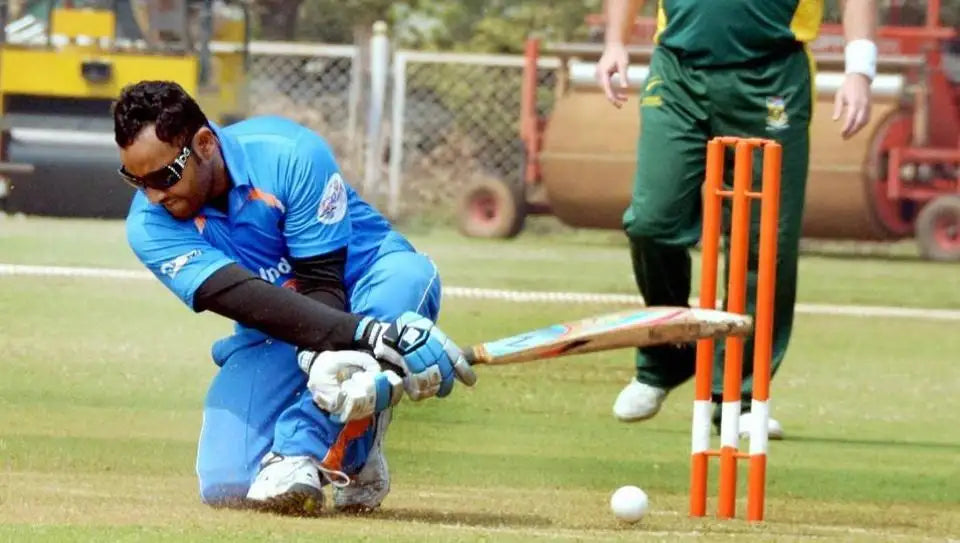Cricket is a one of the most played and loved sports in the world and the essence of the sport is the fact that it is super accessible to all. You don’t need specialized equipment to play the game, you can even use a bamboo stick as a bat and play the game in the smallest of places. Also, one exciting part about the game is how inclusive it is and can be played by anyone, irrespective of gender, age, and physical attributes. Women’s inclusion has shown how the game can break stereotypes and be gender inclusive. But do you know, the sport can also be played by visually impaired players? That’s new to hear, isn’t it?

Credit: Playo
So in this chapter by ZAP, lets dive deep into Blind Cricket and learn more about the format, the rules, the modifications, and the world cups.
How do the visually impaired (Blind) play Cricket?
The visually impaired cricketers obviously cannot play the game in the same way as the other players. There are certain ways the game is modified for blind players. The essence lies in changing the dynamics of the game as per the needs of such players. Usually, visually impaired people rely on their heightened senses of hearing, touch, and spatial awareness to carry out their daily life activities. They use these same heightened senses and skills to participate in and enjoy the sport.

Credit: The Statesman
The ball used in blind cricket has a larger size than the traditional one and is filled with ball bearings, which rattle to produce a unique sound that guides players about its trajectory. The visually impaired players carefully listen to the sound the ball makes on its path and then play the shot according to where the ball is. The stumps are larger and made of fluorescent-colored metal tubes so that blind players can touch them and partially-sighted players can see them so that they can position themselves correctly when bowling or batting.
Blind (Visually Impaired) Cricket Rules:
The basic cricket rules remain the same, but there are some sets of rules tailored to accommodate the unique needs of visually impaired players. Some key Blind Cricket Rules include:
Categories of Players:
Players are categorized into three main groups based on their level of visual impairment - B1 (totally blind), B2 (partially blind players), and B3 (partially sighted players).
Fielding Restriction:
The number of sighted players playing on the pitch is limited. The total number of players in a team remains 11, of which four must be completely blind (B1 category), three partially blind (B2 category), and up to four partially sighted (B3 category).
Bowling and Batting Techniques:
Both players and umpires are required to frequently use verbal signals to have a smooth-flowing game. The bowler must shout "Play!" before his bowling action. If the delivery is bowled to a batsman who is entirely blind, it must pitch at least twice without rolling. If the batsman is partially sighted, the ball is only allowed to bounce once when bowled. Batters very commonly use the sweep shot to increase the chance that the bat will strike the ball. Completely blind batsmen cannot be dismissed out by stumping. They even must be found in front of the stumps (LBW) twice to be judged out. Also, for fielders who are completely blind, are allowed to take a catch the ball with a bounce.
World Blind Cricket Council (WBCC):
Two blind factory workers in Melbourne created the sport in 1922 by improvising it by using a tin can filled with rocks as the ball. Not long after, in 1922, the Victorian Blind Cricket Association was established, and in 1928, the first sports facility and clubhouse for the visually impaired were constructed in Kooyong, Melbourne.
The WBCC was founded during an international cricket meeting that took place in September 1996 in New Delhi, India. The World Blind Cricket Council (WBCC) was established to oversee and promote the sport for the visually impaired worldwide. As of right now, Australia, Bangladesh, England, India, New Zealand, South Africa, Sri Lanka, Pakistan, West Indies, and Nepal are the ten complete members of the WBCC. In November of 1998, New Delhi hosted the first-ever Blind Cricket World Cup, orgainsed by the WBCC, which had seven nations participating.
Also Read: International Cricket Council
Blind Cricket World Cup:
There have been five Blind World Cups organized to date: New Delhi, India (1998), Chennai, India (2002), Islamabad, Pakistan (2006), South Africa (2014), and India (2018). The first-ever world cup in the T20 Format was held in Bangalore in 2012.
The inaugural Blind Cricket World Cup, was held in New Delhi, India, in 1998. South Africa triumphed after defeating Pakistan in the final. The purpose of the event was to empower visually impaired players, and the sponsors, Hotel Kanishka covered a large portion of the teams' costs. When the competition relocated to Chennai, India in 2002, Pakistan took their revenge against South Africa, beating them in the final match. The third World Cup was held in Islamabad in 2006, where Pakistan, led by Aga Shaukat-Ali, defeated India to win the title once more. The 2014 final took place in Cape Town, where India beat Pakistan for the first time. 2018 saw India defend their title after defeating Pakistan in the finals.
Blind Cricket T20 World Cup:
The Indian Blind cricket team has dominated the sport in the T20 format. The T20 Blind World Cup kicked off in 2012 in Bangalore, India. India outplayed Pakistan, winning the final by 29 runs. In 2017, Bengaluru hosted the event again, witnessing India's back to back victory over Pakistan in the final. The most recent edition in 2022, held in Bengaluru, saw India emerging as champions once again by defeating Bangladesh on December 17th, completing a hat trick as champions.
Blind Indian National Team - Cricket Association for the Blind in India (CABI):

Credit: India TV News
George Abraham started the remarkable Blind Indian National Team in 2011 as part of the Cricket Association for the Blind in India (CABI). Formerly known as ACBI, this group uses cricket as more than just a sport, it is a tool to help visually impaired people feel confident and upbeat. Affiliated with the WBCC, The team participates in all One Day International and Twenty20 International matches. The CABI too, ensures, that these players get a chance to shine on a larger stage by organizing regular tournaments and coaching camps.
The Indian National Blind Cricket team has won all three Blind T20 World Cups in 2012, 2017 and in 2022. They have also won the World Cup twice in 2014 and 2018.
FAQ:
Are there fielders in blind cricket?
Yes, every team has 11 players on the field. But the number of sighted players depends in the level of their vision impairment.
Are there age restrictions for Blind Cricket players?
No, there are no age restrictions for visually impaired players to play the sport.
How is fielding managed in Blind Cricket?
Fielders rely on spatial awareness and communication to effectively field the ball and coordinate with teammates.
Now that you have read about the Blink Cricket, here are some more articles we recommend you need:
Day Night Test Matches | First Class Cricket | Decision Review System (DRS)



Share:
From Deccan Chargers to Sunrisers Hyderabad: A Legacy Born in Orange
How many countries in the world play cricket